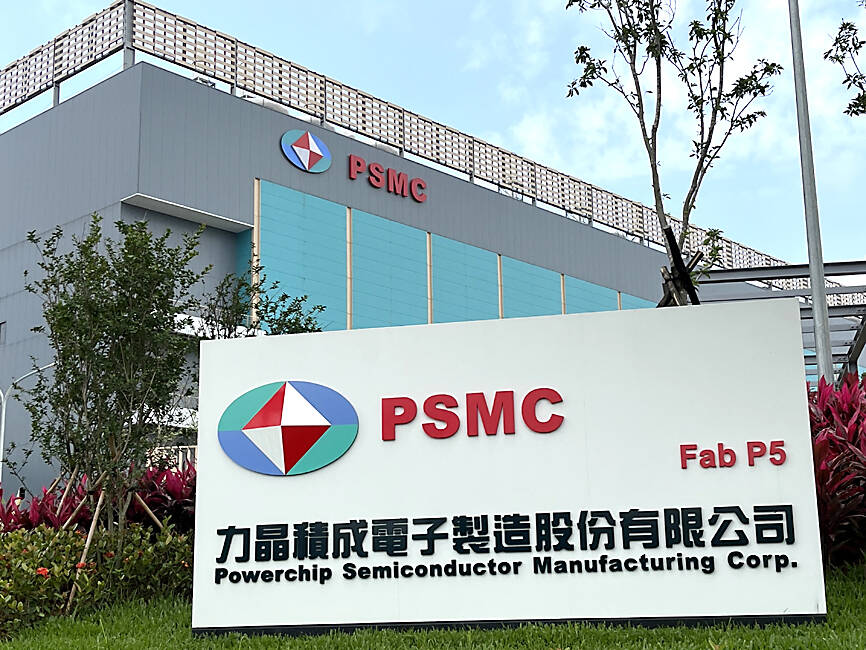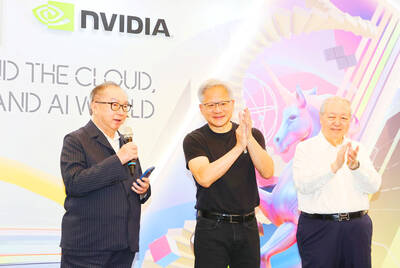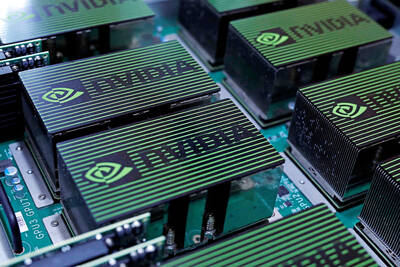Contract chipmaker Powerchip Semiconductor Manufacturing Corp (力積電) yesterday posted deeper quarterly losses of NT$3.33 billion (US$113.07 million) for last quarter, dragged by impairment losses related to foreign-exchange rate fluctuations.
That compared with losses of NT$1.1 billion in the first quarter and NT$1.96 billion in the second quarter last year, the chipmaker said in a report.
Powerchip reported losses per share of NT$0.8 last quarter, expanding from NT$0.26 a quarter earlier and NT$0.54 a year ago.

Photo: Grace Hung, Taipei Times
The appreciation of the New Taiwan dollar incurred NT$1.59 billion in impairment losses on the company’s US dollar-denominated assets, Powerchip president Martin Chu (朱獻國) told an online earnings conference.
The NT dollar gained about 4.89 percent to NT$31.2 against the greenback last quarter, Chu said.
The strong local currency also negatively affected the company’s gross margin, leading to a bigger gross loss of NT$1.02 billion last quarter, compared with gross loss of NT$536 million in the first quarter and gross loss of NT$486 million in the second quarter last year, he said.
Customers are becoming more prudent about placing new orders for the third quarter, as front-loading demand for logic chips cools down ahead of a US tariffs deadline on Friday next week, Powerchip said.
“It requires more observations to get a clearer picture about the third-quarter situation,” Chu said. “Visibility remains low and customers are more conservative.”
Powerchip said it is seeing encouraging signs of recovery with new orders for memory chips flowing in as the world’s major players phase out older-generation DDR4 DRAM chips and low-density single-level-cell NAND flash memory chips.
Improving demand has driven up DRAM prices since last month, Chu said.
The company expects the momentum to carry over into the second half of this year, thanks to recovering demand and healthy inventory.
In addition, demand is increasing for silicon interposers used in advanced Chip-on-Wafer-on-Substrate packaging technology for artificial intelligence chip manufacturing processes, the firm said.
To cope with growing demand, it plans to set aside new capital expenditure of NT$2.65 billion this year to double its silicon interposer capacity, the company added.
The capacity expansion would boost revenue contribution from its silicon interposer business to about 8 percent of the company’s total revenue from 2 percent last quarter, it said.
Powerchip also plans to add new equipment and capacity to boost production of gallium nitride (GaN) semiconductors used in AI servers, as it is to take over from Taiwan Semiconductor Manufacturing Co (TSMC, 台積電) as a new supplier of high-voltage GaN chips to Navitas Semiconductor Inc, it said.
TSMC plans to withdraw from the GaN semiconductor business in two years.
Capital expenditure this year would total US$454 million as planned, Powerchip said.

Leading Taiwanese bicycle brands Giant Manufacturing Co (巨大機械) and Merida Industry Co (美利達工業) on Sunday said that they have adopted measures to mitigate the impact of the tariff policies of US President Donald Trump’s administration. The US announced at the beginning of this month that it would impose a 20 percent tariff on imported goods made in Taiwan, effective on Thursday last week. The tariff would be added to other pre-existing most-favored-nation duties and industry-specific trade remedy levy, which would bring the overall tariff on Taiwan-made bicycles to between 25.5 percent and 31 percent. However, Giant did not seem too perturbed by the

AI SERVER DEMAND: ‘Overall industry demand continues to outpace supply and we are expanding capacity to meet it,’ the company’s chief executive officer said Hon Hai Precision Industry Co (鴻海精密) yesterday reported that net profit last quarter rose 27 percent from the same quarter last year on the back of demand for cloud services and high-performance computing products. Net profit surged to NT$44.36 billion (US$1.48 billion) from NT$35.04 billion a year earlier. On a quarterly basis, net profit grew 5 percent from NT$42.1 billion. Earnings per share expanded to NT$3.19 from NT$2.53 a year earlier and NT$3.03 in the first quarter. However, a sharp appreciation of the New Taiwan dollar since early May has weighed on the company’s performance, Hon Hai chief financial officer David Huang (黃德才)

NVIDIA FACTOR: Shipments of AI servers powered by GB300 chips would undergo pilot runs this quarter, with small shipments possibly starting next quarter, it said Quanta Computer Inc (廣達), which supplies artificial intelligence (AI) servers powered by Nvidia Corp chips, yesterday said that AI servers are on track to account for 70 percent of its total server revenue this year, thanks to improved yield rates and a better learning curve for Nvidia’s GB300 chip-based servers. AI servers accounted for more than 60 percent of its total server revenue in the first half of this year, Quanta chief financial officer Elton Yang (楊俊烈) told an online conference. The company’s latest production learning curve of the AI servers powered by Nvidia’s GB200 chips has improved after overcoming key component

UNPRECEDENTED DEAL: The arrangement which also includes AMD risks invalidating the national security rationale for US export controls, an expert said Nvidia Corp and Advanced Micro Devices Inc (AMD) have agreed to pay 15 percent of their revenue from Chinese artificial intelligence (AI) chip sales to the US government in a deal to secure export licenses, an unusual arrangement that might unnerve both US companies and Beijing. Nvidia plans to share 15 percent of the revenue from sales of its H20 AI accelerator in China, a person familiar with the matter said. AMD is to deliver the same share from MI308 revenue, the person added, asking for anonymity to discuss internal deliberations. The arrangement reflects US President Donald Trump’s consistent effort to engineer